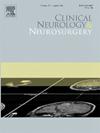颅内动脉狭窄引起的分水岭梗死患者复发性缺血性脑卒中的预测因素
IF 1.8
4区 医学
Q3 CLINICAL NEUROLOGY
引用次数: 0
摘要
背景与目的:症状性颅内动脉狭窄(sICAS)与缺血性卒中复发风险升高密切相关,但潜在的危险因素尚不清楚。在本研究中,我们旨在探讨ICAS引起的分水岭梗死患者复发性缺血性脑卒中的危险因素和影像学特征的预测价值。方法前瞻性收集ICAS所致分水岭梗死患者的临床资料和影像学资料。主要终点为同一区域1年内复发性缺血性脑血管事件。原始磁共振图像(MRI)通过快速处理的缺血性卒中(F-Stroke)软件进行后处理,计算灌注参数。白质高强度(WMH)按Fazekas量表评定。采用二元logistic回归分析探讨影像学特征与缺血性脑卒中复发的关系。随后,我们进行ROC曲线分析,以确定他们对缺血性卒中复发的区分能力。结果139例患者成功入组。复发率为18.71% %。与无复发性缺血性卒中患者相比,复发患者有较高的缺血性卒中史(25.66 % vs. 53.85 %)和严重WMH(30.77 % vs. 7.97 %),基线NIHSS评分和Tmax容量 4 s较高。Logistic回归分析显示Tmax >; 4 s和重度WMH均对缺血性脑卒中复发风险有显著影响。此外,ROC曲线分析表明,Tmax >; 4 s的体积判别能力(AUC = 0.64, 95 %CI = 0.51-0.77, P = 0.029)略优于WMH评分(AUC = 0.62, 95 %CI = 0.49-0.75, P = 0.066)。而Tmax >; 4 s的体积与WMH评分的组合表现出更好的区分能力(AUC = 0.73, 95 %CI = 0.61-0.85, P <; 0.001)。结论磁共振引导的脑灌注不足和严重WMH易引起缺血性脑卒中复发,可作为预测ICAS所致分水岭梗死患者复发的重要指标。本文章由计算机程序翻译,如有差异,请以英文原文为准。
Predictors for recurrent ischemic stroke in patients with watershed infarct induced by intracranial artery stenosis
Background and purpose
Symptomatic intracranial artery stenosis (sICAS) is strongly associated with an elevated risk of recurrent ischemic stroke, yet the underlying risk factors remain elusive. In this present study, we aimed to investigate the risk factors and predictive value of imaging features for recurrent ischemic stroke in patients with watershed infarction caused by ICAS.
Methods
We prospectively collected clinical information and imaging data from patients with watershed infarction caused by ICAS. The primary outcome was recurrent ischemic cerebrovascular events in the same territory within 1 year. The original magnetic resonance images (MRI) were post-processed by the Fast-processing of ischemic stroke (F-Stroke) software to compute the perfusion parameters. The assessment of white matter hyperintensity (WMH) was performed in accordance with the Fazekas scale. Binary logistic regression analysis was performed to explore the association of imaging characteristics and recurrent ischemic stroke. Subsequently, we performed ROC curve analyses to determine their discriminatory capacity for ischemic stroke recurrence.
Results
A total of 139 patients were successfully enrolled in the present study. The recurrence rate in the total population was 18.71 %. Compared with patients without recurrent ischemic stroke, those who experienced recurrence had a higher proportion of prior ischemic stroke history (25.66 % vs. 53.85 %) and severe WMH (30.77 % vs. 7.97 %), as well as higher baseline NIHSS scores and volume of Tmax > 4 s. Logistic regression analysis revealed that both the volume of Tmax > 4 s and severe WMH significantly influenced the risk of recurrent ischemic stroke occurrence. Furthermore, ROC curve analyses demonstrated that the discriminatory capacity of the volume of Tmax > 4 s (AUC = 0.64, 95 %CI = 0.51–0.77, P = 0.029) was marginally superior to WMH scores (AUC = 0.62, 95 %CI = 0.49–0.75, P = 0.066). Whereas, the combination of the volume of Tmax > 4 s and the WMH scores showed better discriminatory capacity (AUC = 0.73, 95 %CI = 0.61–0.85, P < 0.001).
Conclusion
MR-guiding cerebral hypoperfusion and severe WMH is susceptible to recurrence of ischemic stroke, thereby serving as valuable predictors for recurrence in patients with watershed infarction caused by ICAS.
求助全文
通过发布文献求助,成功后即可免费获取论文全文。
去求助
来源期刊

Clinical Neurology and Neurosurgery
医学-临床神经学
CiteScore
3.70
自引率
5.30%
发文量
358
审稿时长
46 days
期刊介绍:
Clinical Neurology and Neurosurgery is devoted to publishing papers and reports on the clinical aspects of neurology and neurosurgery. It is an international forum for papers of high scientific standard that are of interest to Neurologists and Neurosurgeons world-wide.
 求助内容:
求助内容: 应助结果提醒方式:
应助结果提醒方式:


